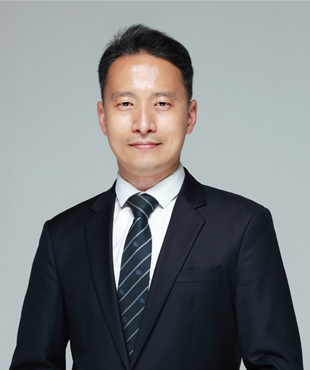Our bi-weekly Opinion provides you with latest updates and analysis on major capital market and financial investment industry issues.
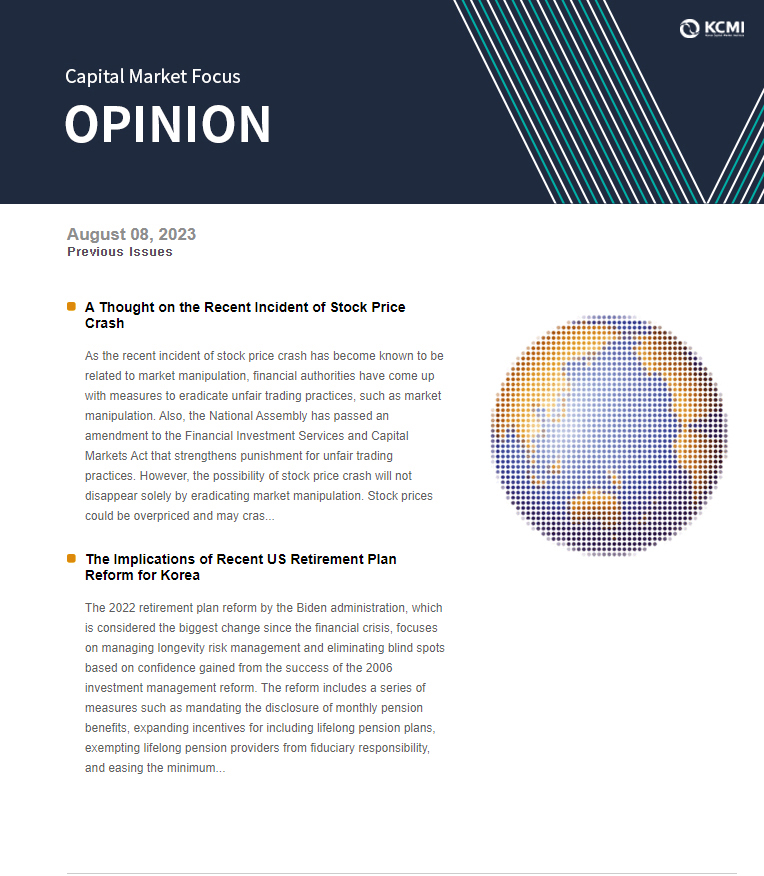
Population Decline and Labor Resources in Korea: Current State and Implications
Publication date Nov. 07, 2023
Summary
Korea’s labor force is on the decline. Considering ongoing population aging and gender imbalances in labor force participation, Korea has two policy directions to expand the labor force: one for increasing elderly workers and the other for boosting the female workforce. However, given that labor force participation among elderly men has already reached a high level, the ultimate solution comes down to women’s greater participation in the labor market. Unlike major economies, the labor force participation rate for Korean women is low on average and it exhibits a distinctive M-shaped curve for their age group. The latter is attributable to their labor market exits during child-rearing years. Hence, the development of policies should be geared toward targeting women who go through the child-rearing stage, aimed for expanding the internal labor force base. These policy efforts are expected to serve as a crucial driving force for enhancing stock market returns as well as the real economy.
As suggested by the population trend, Korea’s labor input has already entered a declining phase after passing its peak. Figure 1 represents the level of labor inputs in the private sector since the 1980s,1) shown in a solid line, along with the nonlinearly2) estimated trend in a dotted line. This suggests that labor input reached its peak around 2010 and has been declining since then.
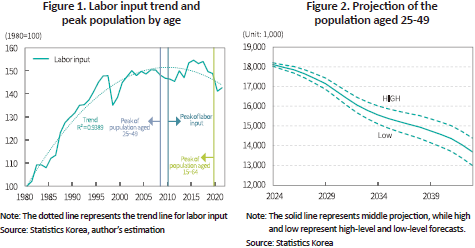
Compared to the timing of reaching peak population by age, the peak timing of labor input seems closer to that of the population aged 25 to 49, rather than those aged between 15 and 64 including the entire working age population. As marked in the vertical line in Figure 1, the population aged 15 to 64 reached the highest level around 2019, while the peak of those aged 25 to 49 was around 2008, which is closely approximate to the peak of labor input. People aged 25 to 49 represent a majority of the entire population3) and exclude minors and retirees who consist mainly of part-time, economically inactive population,4) making it a better proxy for the actual labor input trend.
Considering the characteristics of the population trend, the potential level of the available labor force can be initially projected by the population aged 25 to 49. According to the median population forecast by Statistics Korea as presented in Figure 2, the population between the ages 25 and 49 is expected to fall by approximately 24% over two decades, from 18.1 million in 2024 to 13.7 million in 2043. The population decline in this age group also aligns with Statistics Korea’s high-level forecast, albeit with some variations.5) Eventually, a reduction of nearly a quarter of the core labor force is expected in 20 years, placing significant constraints on production activities of firms.
Amid the future decline in the ages 25 to 49 to be accompanied by population aging, it is worth considering promoting labor force participation of the elderly as a way to compensate for the lack of workforce. In addition, given the serious gender disparity in labor force participation in Korea, another strategy lies in facilitating women’s participation in the labor market. In the following discussion, this article examines the current state and possibility of enhancing labor force participation among the elderly and women.
The elderly’s participation in the labor market
In Korea, population aging combined with population decline is expected to bring about substantial changes in population structure. With the increase in life expectancy driven by improvements in healthcare and medical standards, the share of the population aged 65 and over is anticipated to nearly double over the next 20 years, from 19.4% in 2024 to 36.1% in 2043. Accordingly, amid a growing need for financial independence in old age, the elderly’s participation in the labor market is increasing. When analyzing the labor force participation rate for people aged 50 and over, they can be divided into two age groups of 50-59 and 60 and above. The two groups show quite a large difference in labor force participation rates (50-59: 78.4%, 60 and above: 45.8%, as of 2022). However, the growth of labor force participation is of a similar level among both age groups. The labor force participation rate rose by approximately 10 percentage points from 68.8% in 2000 to 78.4% in 2022 among the ages 50 to 59, while increasing by about 8 percentage points from 38.2% to 45.8% among the population aged 60 and above.
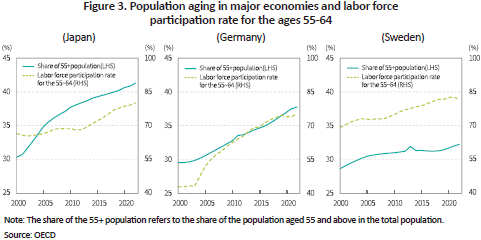
In terms of the elderly’s labor force participation, Korea is evaluated as the upper-medium level compared to other major economies. The average rate for OECD countries (the age group between 55 and 64 in 2022) stands at 67.4%, which is slightly lower than 70.3% of Korea. Notably, countries like Japan, Germany and Sweden, which have experienced population aging ahead of Korea, are placed in the top tier with rates of 75 to 82%, showing a considerable difference. In the three countries mentioned above, population aging has led to the continuous expansion of labor force participation among the elderly. This can be demonstrated in the share of the population aged 55 and over and labor force participation rates for those aged 55 to 64 in each country, as illustrated in Figure 3. Japan and Sweden reached the current level of Korea in the early 2010s and 2000s, respectively, and have experienced significant increases. As is the case with these countries, Korea is likely to see a stable rise in the share of the elderly participating in the labor market. This may be driven by significantly improved education levels of the young generation6) as well as improvements in healthcare and the need for retirement planning. Human capital has become immensely sophisticated compared to the past, thereby increasing the likelihood that the elderly are efficiently utilized for production activities.
Even if the older population is increasingly participating in the labor market, it should be noted that the extent of participation may vary based on specific age groups or gender. Figure 4 presents the average labor force participation rate for the population aged 50 to 647) by gender in five-year intervals. First, Figure 4 highlights that labor force participation rates for both men and women remarkably decrease as they reach the ages of 60 to 64. It can be attributable to the fact that they reach retirement age, resulting in a significant number of retirees. Second, it is notable that male labor force participation rates are more pronounced in each age group. Based on the average rates for the years 2020 to 2022, for instance, the participation rates for men in the 50-54 and 55-59 age groups are approximately 90% and 87%, respectively, which is significantly higher compared to women whose participation rates stand at 69% and 64% in the same age groups. These facts imply that the labor force participation for the 50-59 age group may noticeably expand if women in that age group actively take part in the labor market. It seems hard to ignore the possibility of increasing the rate by facilitating men’s participation in the labor market. Considering that 94%8) of most actively working male population aged 40 to 44 are participating in the labor market, however, there is not much room for boosting men’s participation in all age groups excluding the 60 to 64 population.
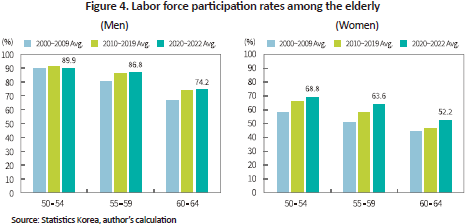
Women’s labor force participation
Although this article has mainly focused on the elderly group so far, it is well known that overall labor participation by women stays low in Korea. As of 2022, the labor force participation rate for adult women (aged 20 to 64) stands at 65%, which is nearly 20 percentage points lower than that of men. Furthermore, Korea is one of the OECD countries that have the lowest labor participation rate for women. In Korea, adult women’s participation rate is below the average (70%) and falls under the bottom 20% bracket, representing a considerable gap with countries in the upper bracket such as Sweden (85%) and other Scandinavian countries, as well as Germany (79%) and Japan (79%).
Furthermore, Korea is suffering from serious labor and human capital losses due to women’s labor market exits or career interruptions. Table 1 shows how the labor force participation rate for the cohort of women aged 25 to 29 changed in 10 years. In the column labeled 2005→2015, the labor force participation rate for women aged 25 to 29 stood at 66.2% in 2005, which declined to 55.9% by 10.3 percentage points in 2015 when they became 35 to 39 years old. This tendency is similarly observed in women who belonged to the 25-29 age group during the years 2006 to 2012. For instance, the labor force participation rate for women in that age group in 2012 decreased by 9.4 percentage points after 10 years, from 71.5% to 62.1%, representing a similar extent of reduction. Despite a slight increase in the rate for women aged 35 to 39 (55.9% in 2015 to 62.1% in 2022), the proportion of the net outflow (exit) from the labor market showed little change.

In a cross-sectional analysis, Korea’s female labor force participation rates by age exhibit an M-shaped curve (Park & Kim. 2003; Nam & Shin, 2022). This can be explicitly demonstrated by age-specific female labor force participation rates in both Korea and major countries, as shown in Figure 5. In Korea, the rate generally reaches a high level for women aged 25 to 29, and then abruptly plunges among those in their 30s, and continues to rise for those in their 40s or older. Among major economies, Japan has a similar pattern to Korea, but its curve is somewhat gradual. On the other hand, Germany and Sweden show an inverted U-shaped curve,9) a stark contrast to Korea’s M-shaped curve. As observed in the previous cohort analysis, a significantly large share of Korean women exit from the labor market in their mid to late 30s.10) This pattern has persisted, which has made Korea not able to depart from the M-shaped curve. This is fundamentally attributed to structural constraints that the burden of childbirth and childcare11) imposes on women (Yeo et al., 2003; Nam & Shin, 2022). The M-shaped curve indicates the possibility of re-entering the labor market at some point. However, it is evident that career interruptions experienced by women lead to the loss of human capital and additional costs required for retraining, both tangible and intangible.
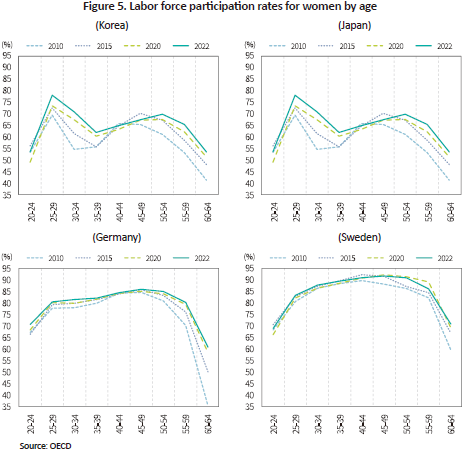
Implications
In the face of imminent population decline, a crucial challenge is the expansion of the workforce base to achieve growth potential. Some advanced countries have actively implemented immigration policies12) to address labor shortages. As many countries are likely to experience population decline and aging, competition for attracting immigrants is expected to intensify going forward. Korea also needs to explore ways to accept more foreign workers through efficient immigration policies. However, significant uncertainty is inherent in immigration policies due to external factors such as evolving immigration and labor policies adopted by each country and language and cultural barriers to the entry of immigrants.
Against this backdrop, substantial policy efforts should be dedicated to bolstering the internal base of labor resources. In this respect, the policy for boosting labor force participation can be divided into two directions, one for the older population and the other for the female population. As stated above, however, labor force participation rates for elderly men have already reached a high level, which rarely leaves much room for improvement within that group. Hence, policy focus should be placed on increasing labor force participation rates for women.
In a sense, the M-shaped curve for female labor force participation in Korea can also be interpreted as high motivation for women to re-enter the labor market after child-rearing years. If the government designs policies for women who go through the child-rearing stage as a way of reducing labor market exits, their labor force participation can be spontaneously expanded in the later stages of the life cycle. On top of that, if the environment is created for women to accumulate experience and job skills without interruptions, social costs resulting from human capital losses could be curtailed to a large extent.
The financial market is not independent of the labor market, albeit being seemingly separate. Real interest rates and stock prices move in sync with the real economy, and all economic activities depend on labor resources. In particular, stock returns empirically have a positive relationship with returns on capital investments, and available labor resources are projected to heavily affect future capital investment returns. The author’s estimates find that if female labor supply increases by 0.5% per year for 20 years, annual capital investment returns for the same period are expected to climb, on average, by around 1 percentage point.
The lack of female labor force participation in Korea suggests that significant constraints are being placed on the utilization of production factors. On the other hand, however, this also implies that there is room for boosting growth potential through improvements. If policy efforts are made to effectively realize such potential, it will act as a crucial driving force for enhancing stock market returns.
1) Labor input is derived from the number of workers multiplied by the average working hours.
2) As the explanatory power of a nonlinear (cubic) trend (R2=0.94) is much higher than that of a linear trend (R2=0.69), this article uses the nonlinear model. When using a quadratic model, there is no significant change in timing the peak.
3) The population aged 25 to 49 is larger than the combined population of those aged 15 to 24 and 50 to 64 during the entire period from 1981 to 2023. For the next two decades, it is projected that these two groups (aged 25 to 49 and 50 to 64) will have a similar number of population, according to the median estimate released by Statistics Korea.
4) A significant portion of those aged 50 and above is expected to retire early before they reach retirement age.
5) As of 2043, the projected high-level population is approximately 5% larger than the median estimate.
6) In Korea, the tertiary educational attainment of young adults aged 25 to 34 (university degree completion) increased from 38.5% in 2000 to approximately 69.3% in 2021, representing nearly a two-fold increase.
7) In terms of additional labor force participation, the population aged 50 to 64 is more likely to show a higher participation rate than older age groups, considering physical limitations and other practical constraints. Accordingly, this article focuses on the population aged 50 to 64.
8) The average for 2000 to 2020 is 94%, equal to that for 2010 to 2022.
9) Sweden and Germany deviated from the M-shaped curve early on. In these countries, the M-shaped curve was observed until the 1970s and 1980s (Yeo, Y.J. et al., 2013).
10) The higher labor force participation rate of people in their 40s can be the result of the reduced child-rearing burden or an increase in economic necessity.
11) Women’s average age at the birth of their first child has been 32 to 33 years over the past decade, indicating that many of their children are not yet of school age until these women reach their mid to late 30s.
12) In the case of Canada (with 39.6 million population as of January 1, 2023), the population showed an abrupt increase of nearly one million in 2022, and 96% of this increase is attributed to immigration.
References
Kang, H.J., 2022, The impact of demographic changes on long-term macroeconomic prospects, KCMI Issue Report, 22-26.
Nam, J.R. and Shin, S.H., 2022, A lifelong study of women’s labor market dynamics: Focusing on gender wage gap, Quarterly Journal of Labor Policy of Korea Labor Institute, 2022-19.
Park, K.S. and Kim, Y.H., 2003, Patterns of Korean Women’s Life Course, Korea Journal of Population Studies 26 (2), 63-90.
Yeo, Y.J., Kim, S.J., Kim, E.J. and Choi, J.Y., 2013, Strategies for promoting women’s employment, KIHASA Research Report, 2013-31-06.

Compared to the timing of reaching peak population by age, the peak timing of labor input seems closer to that of the population aged 25 to 49, rather than those aged between 15 and 64 including the entire working age population. As marked in the vertical line in Figure 1, the population aged 15 to 64 reached the highest level around 2019, while the peak of those aged 25 to 49 was around 2008, which is closely approximate to the peak of labor input. People aged 25 to 49 represent a majority of the entire population3) and exclude minors and retirees who consist mainly of part-time, economically inactive population,4) making it a better proxy for the actual labor input trend.
Considering the characteristics of the population trend, the potential level of the available labor force can be initially projected by the population aged 25 to 49. According to the median population forecast by Statistics Korea as presented in Figure 2, the population between the ages 25 and 49 is expected to fall by approximately 24% over two decades, from 18.1 million in 2024 to 13.7 million in 2043. The population decline in this age group also aligns with Statistics Korea’s high-level forecast, albeit with some variations.5) Eventually, a reduction of nearly a quarter of the core labor force is expected in 20 years, placing significant constraints on production activities of firms.
Amid the future decline in the ages 25 to 49 to be accompanied by population aging, it is worth considering promoting labor force participation of the elderly as a way to compensate for the lack of workforce. In addition, given the serious gender disparity in labor force participation in Korea, another strategy lies in facilitating women’s participation in the labor market. In the following discussion, this article examines the current state and possibility of enhancing labor force participation among the elderly and women.
The elderly’s participation in the labor market
In Korea, population aging combined with population decline is expected to bring about substantial changes in population structure. With the increase in life expectancy driven by improvements in healthcare and medical standards, the share of the population aged 65 and over is anticipated to nearly double over the next 20 years, from 19.4% in 2024 to 36.1% in 2043. Accordingly, amid a growing need for financial independence in old age, the elderly’s participation in the labor market is increasing. When analyzing the labor force participation rate for people aged 50 and over, they can be divided into two age groups of 50-59 and 60 and above. The two groups show quite a large difference in labor force participation rates (50-59: 78.4%, 60 and above: 45.8%, as of 2022). However, the growth of labor force participation is of a similar level among both age groups. The labor force participation rate rose by approximately 10 percentage points from 68.8% in 2000 to 78.4% in 2022 among the ages 50 to 59, while increasing by about 8 percentage points from 38.2% to 45.8% among the population aged 60 and above.

In terms of the elderly’s labor force participation, Korea is evaluated as the upper-medium level compared to other major economies. The average rate for OECD countries (the age group between 55 and 64 in 2022) stands at 67.4%, which is slightly lower than 70.3% of Korea. Notably, countries like Japan, Germany and Sweden, which have experienced population aging ahead of Korea, are placed in the top tier with rates of 75 to 82%, showing a considerable difference. In the three countries mentioned above, population aging has led to the continuous expansion of labor force participation among the elderly. This can be demonstrated in the share of the population aged 55 and over and labor force participation rates for those aged 55 to 64 in each country, as illustrated in Figure 3. Japan and Sweden reached the current level of Korea in the early 2010s and 2000s, respectively, and have experienced significant increases. As is the case with these countries, Korea is likely to see a stable rise in the share of the elderly participating in the labor market. This may be driven by significantly improved education levels of the young generation6) as well as improvements in healthcare and the need for retirement planning. Human capital has become immensely sophisticated compared to the past, thereby increasing the likelihood that the elderly are efficiently utilized for production activities.
Even if the older population is increasingly participating in the labor market, it should be noted that the extent of participation may vary based on specific age groups or gender. Figure 4 presents the average labor force participation rate for the population aged 50 to 647) by gender in five-year intervals. First, Figure 4 highlights that labor force participation rates for both men and women remarkably decrease as they reach the ages of 60 to 64. It can be attributable to the fact that they reach retirement age, resulting in a significant number of retirees. Second, it is notable that male labor force participation rates are more pronounced in each age group. Based on the average rates for the years 2020 to 2022, for instance, the participation rates for men in the 50-54 and 55-59 age groups are approximately 90% and 87%, respectively, which is significantly higher compared to women whose participation rates stand at 69% and 64% in the same age groups. These facts imply that the labor force participation for the 50-59 age group may noticeably expand if women in that age group actively take part in the labor market. It seems hard to ignore the possibility of increasing the rate by facilitating men’s participation in the labor market. Considering that 94%8) of most actively working male population aged 40 to 44 are participating in the labor market, however, there is not much room for boosting men’s participation in all age groups excluding the 60 to 64 population.

Women’s labor force participation
Although this article has mainly focused on the elderly group so far, it is well known that overall labor participation by women stays low in Korea. As of 2022, the labor force participation rate for adult women (aged 20 to 64) stands at 65%, which is nearly 20 percentage points lower than that of men. Furthermore, Korea is one of the OECD countries that have the lowest labor participation rate for women. In Korea, adult women’s participation rate is below the average (70%) and falls under the bottom 20% bracket, representing a considerable gap with countries in the upper bracket such as Sweden (85%) and other Scandinavian countries, as well as Germany (79%) and Japan (79%).
Furthermore, Korea is suffering from serious labor and human capital losses due to women’s labor market exits or career interruptions. Table 1 shows how the labor force participation rate for the cohort of women aged 25 to 29 changed in 10 years. In the column labeled 2005→2015, the labor force participation rate for women aged 25 to 29 stood at 66.2% in 2005, which declined to 55.9% by 10.3 percentage points in 2015 when they became 35 to 39 years old. This tendency is similarly observed in women who belonged to the 25-29 age group during the years 2006 to 2012. For instance, the labor force participation rate for women in that age group in 2012 decreased by 9.4 percentage points after 10 years, from 71.5% to 62.1%, representing a similar extent of reduction. Despite a slight increase in the rate for women aged 35 to 39 (55.9% in 2015 to 62.1% in 2022), the proportion of the net outflow (exit) from the labor market showed little change.

In a cross-sectional analysis, Korea’s female labor force participation rates by age exhibit an M-shaped curve (Park & Kim. 2003; Nam & Shin, 2022). This can be explicitly demonstrated by age-specific female labor force participation rates in both Korea and major countries, as shown in Figure 5. In Korea, the rate generally reaches a high level for women aged 25 to 29, and then abruptly plunges among those in their 30s, and continues to rise for those in their 40s or older. Among major economies, Japan has a similar pattern to Korea, but its curve is somewhat gradual. On the other hand, Germany and Sweden show an inverted U-shaped curve,9) a stark contrast to Korea’s M-shaped curve. As observed in the previous cohort analysis, a significantly large share of Korean women exit from the labor market in their mid to late 30s.10) This pattern has persisted, which has made Korea not able to depart from the M-shaped curve. This is fundamentally attributed to structural constraints that the burden of childbirth and childcare11) imposes on women (Yeo et al., 2003; Nam & Shin, 2022). The M-shaped curve indicates the possibility of re-entering the labor market at some point. However, it is evident that career interruptions experienced by women lead to the loss of human capital and additional costs required for retraining, both tangible and intangible.

Implications
In the face of imminent population decline, a crucial challenge is the expansion of the workforce base to achieve growth potential. Some advanced countries have actively implemented immigration policies12) to address labor shortages. As many countries are likely to experience population decline and aging, competition for attracting immigrants is expected to intensify going forward. Korea also needs to explore ways to accept more foreign workers through efficient immigration policies. However, significant uncertainty is inherent in immigration policies due to external factors such as evolving immigration and labor policies adopted by each country and language and cultural barriers to the entry of immigrants.
Against this backdrop, substantial policy efforts should be dedicated to bolstering the internal base of labor resources. In this respect, the policy for boosting labor force participation can be divided into two directions, one for the older population and the other for the female population. As stated above, however, labor force participation rates for elderly men have already reached a high level, which rarely leaves much room for improvement within that group. Hence, policy focus should be placed on increasing labor force participation rates for women.
In a sense, the M-shaped curve for female labor force participation in Korea can also be interpreted as high motivation for women to re-enter the labor market after child-rearing years. If the government designs policies for women who go through the child-rearing stage as a way of reducing labor market exits, their labor force participation can be spontaneously expanded in the later stages of the life cycle. On top of that, if the environment is created for women to accumulate experience and job skills without interruptions, social costs resulting from human capital losses could be curtailed to a large extent.
The financial market is not independent of the labor market, albeit being seemingly separate. Real interest rates and stock prices move in sync with the real economy, and all economic activities depend on labor resources. In particular, stock returns empirically have a positive relationship with returns on capital investments, and available labor resources are projected to heavily affect future capital investment returns. The author’s estimates find that if female labor supply increases by 0.5% per year for 20 years, annual capital investment returns for the same period are expected to climb, on average, by around 1 percentage point.
The lack of female labor force participation in Korea suggests that significant constraints are being placed on the utilization of production factors. On the other hand, however, this also implies that there is room for boosting growth potential through improvements. If policy efforts are made to effectively realize such potential, it will act as a crucial driving force for enhancing stock market returns.
1) Labor input is derived from the number of workers multiplied by the average working hours.
2) As the explanatory power of a nonlinear (cubic) trend (R2=0.94) is much higher than that of a linear trend (R2=0.69), this article uses the nonlinear model. When using a quadratic model, there is no significant change in timing the peak.
3) The population aged 25 to 49 is larger than the combined population of those aged 15 to 24 and 50 to 64 during the entire period from 1981 to 2023. For the next two decades, it is projected that these two groups (aged 25 to 49 and 50 to 64) will have a similar number of population, according to the median estimate released by Statistics Korea.
4) A significant portion of those aged 50 and above is expected to retire early before they reach retirement age.
5) As of 2043, the projected high-level population is approximately 5% larger than the median estimate.
6) In Korea, the tertiary educational attainment of young adults aged 25 to 34 (university degree completion) increased from 38.5% in 2000 to approximately 69.3% in 2021, representing nearly a two-fold increase.
7) In terms of additional labor force participation, the population aged 50 to 64 is more likely to show a higher participation rate than older age groups, considering physical limitations and other practical constraints. Accordingly, this article focuses on the population aged 50 to 64.
8) The average for 2000 to 2020 is 94%, equal to that for 2010 to 2022.
9) Sweden and Germany deviated from the M-shaped curve early on. In these countries, the M-shaped curve was observed until the 1970s and 1980s (Yeo, Y.J. et al., 2013).
10) The higher labor force participation rate of people in their 40s can be the result of the reduced child-rearing burden or an increase in economic necessity.
11) Women’s average age at the birth of their first child has been 32 to 33 years over the past decade, indicating that many of their children are not yet of school age until these women reach their mid to late 30s.
12) In the case of Canada (with 39.6 million population as of January 1, 2023), the population showed an abrupt increase of nearly one million in 2022, and 96% of this increase is attributed to immigration.
References
Kang, H.J., 2022, The impact of demographic changes on long-term macroeconomic prospects, KCMI Issue Report, 22-26.
Nam, J.R. and Shin, S.H., 2022, A lifelong study of women’s labor market dynamics: Focusing on gender wage gap, Quarterly Journal of Labor Policy of Korea Labor Institute, 2022-19.
Park, K.S. and Kim, Y.H., 2003, Patterns of Korean Women’s Life Course, Korea Journal of Population Studies 26 (2), 63-90.
Yeo, Y.J., Kim, S.J., Kim, E.J. and Choi, J.Y., 2013, Strategies for promoting women’s employment, KIHASA Research Report, 2013-31-06.
